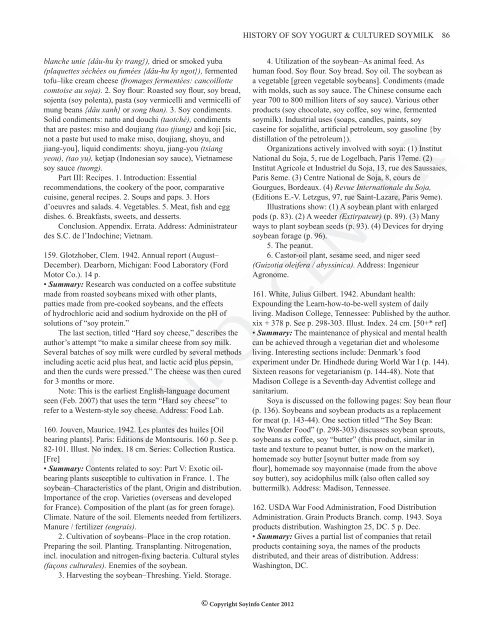history of soy yogurt, soy acidophilus milk and other ... - SoyInfo Center
history of soy yogurt, soy acidophilus milk and other ... - SoyInfo Center
history of soy yogurt, soy acidophilus milk and other ... - SoyInfo Center
You also want an ePaper? Increase the reach of your titles
YUMPU automatically turns print PDFs into web optimized ePapers that Google loves.
lanche unie {dâu-hu ky trang}), dried or smoked yuba<br />
(plaquettes séchées ou fumées {dâu-hu ky ngot}), fermented<br />
t<strong>of</strong>u–like cream cheese (fromages fermentées: cancoillotte<br />
comtoise au soja). 2. Soy fl our: Roasted <strong>soy</strong> fl our, <strong>soy</strong> bread,<br />
sojenta (<strong>soy</strong> polenta), pasta (<strong>soy</strong> vermicelli <strong>and</strong> vermicelli <strong>of</strong><br />
mung beans {dâu xanh} or song than). 3. Soy condiments.<br />
Solid condiments: natto <strong>and</strong> douchi (taotché), condiments<br />
that are pastes: miso <strong>and</strong> doujiang (tao tjiung) <strong>and</strong> koji [sic,<br />
not a paste but used to make miso, doujiang, shoyu, <strong>and</strong><br />
jiang-you], liquid condiments: shoyu, jiang-you (tsiang<br />
yeou), (tao yu), ketjap (Indonesian <strong>soy</strong> sauce), Vietnamese<br />
<strong>soy</strong> sauce (tuong).<br />
Part III: Recipes. 1. Introduction: Essential<br />
recommendations, the cookery <strong>of</strong> the poor, comparative<br />
cuisine, general recipes. 2. Soups <strong>and</strong> paps. 3. Hors<br />
d’oeuvres <strong>and</strong> salads. 4. Vegetables. 5. Meat, fi sh <strong>and</strong> egg<br />
dishes. 6. Breakfasts, sweets, <strong>and</strong> desserts.<br />
Conclusion. Appendix. Errata. Address: Administrateur<br />
des S.C. de l’Indochine; Vietnam.<br />
159. Glotzhober, Clem. 1942. Annual report (August–<br />
December). Dearborn, Michigan: Food Laboratory (Ford<br />
Motor Co.). 14 p.<br />
• Summary: Research was conducted on a c<strong>of</strong>fee substitute<br />
made from roasted <strong>soy</strong>beans mixed with <strong>other</strong> plants,<br />
patties made from pre-cooked <strong>soy</strong>beans, <strong>and</strong> the effects<br />
<strong>of</strong> hydrochloric acid <strong>and</strong> sodium hydroxide on the pH <strong>of</strong><br />
solutions <strong>of</strong> “<strong>soy</strong> protein.”<br />
The last section, titled “Hard <strong>soy</strong> cheese,” describes the<br />
author’s attempt “to make a similar cheese from <strong>soy</strong> <strong>milk</strong>.<br />
Several batches <strong>of</strong> <strong>soy</strong> <strong>milk</strong> were curdled by several methods<br />
including acetic acid plus heat, <strong>and</strong> lactic acid plus pepsin,<br />
<strong>and</strong> then the curds were pressed.” The cheese was then cured<br />
for 3 months or more.<br />
Note: This is the earliest English-language document<br />
seen (Feb. 2007) that uses the term “Hard <strong>soy</strong> cheese” to<br />
refer to a Western-style <strong>soy</strong> cheese. Address: Food Lab.<br />
160. Jouven, Maurice. 1942. Les plantes des huiles [Oil<br />
bearing plants]. Paris: Editions de Montsouris. 160 p. See p.<br />
82-101. Illust. No index. 18 cm. Series: Collection Rustica.<br />
[Fre]<br />
• Summary: Contents related to <strong>soy</strong>: Part V: Exotic oilbearing<br />
plants susceptible to cultivation in France. 1. The<br />
<strong>soy</strong>bean–Characteristics <strong>of</strong> the plant, Origin <strong>and</strong> distribution.<br />
Importance <strong>of</strong> the crop. Varieties (overseas <strong>and</strong> developed<br />
for France). Composition <strong>of</strong> the plant (as for green forage).<br />
Climate. Nature <strong>of</strong> the soil. Elements needed from fertilizers.<br />
Manure / fertilizer (engrais).<br />
2. Cultivation <strong>of</strong> <strong>soy</strong>beans–Place in the crop rotation.<br />
Preparing the soil. Planting. Transplanting. Nitrogenation,<br />
incl. inoculation <strong>and</strong> nitrogen-fi xing bacteria. Cultural styles<br />
(façons culturales). Enemies <strong>of</strong> the <strong>soy</strong>bean.<br />
3. Harvesting the <strong>soy</strong>bean–Threshing. Yield. Storage.<br />
HISTORY OF SOY YOGURT & CULTURED SOYMILK 86<br />
© Copyright Soyinfo <strong>Center</strong> 2012<br />
4. Utilization <strong>of</strong> the <strong>soy</strong>bean–As animal feed. As<br />
human food. Soy fl our. Soy bread. Soy oil. The <strong>soy</strong>bean as<br />
a vegetable [green vegetable <strong>soy</strong>beans]. Condiments (made<br />
with molds, such as <strong>soy</strong> sauce. The Chinese consume each<br />
year 700 to 800 million liters <strong>of</strong> <strong>soy</strong> sauce). Various <strong>other</strong><br />
products (<strong>soy</strong> chocolate, <strong>soy</strong> c<strong>of</strong>fee, <strong>soy</strong> wine, fermented<br />
<strong>soy</strong><strong>milk</strong>). Industrial uses (soaps, c<strong>and</strong>les, paints, <strong>soy</strong><br />
caseine for sojalithe, artifi cial petroleum, <strong>soy</strong> gasoline {by<br />
distillation <strong>of</strong> the petroleum}).<br />
Organizations actively involved with <strong>soy</strong>a: (1) Institut<br />
National du Soja, 5, rue de Logelbach, Paris 17eme. (2)<br />
Institut Agricole et Industriel du Soja, 13, rue des Saussaies,<br />
Paris 8eme. (3) Centre National de Soja, 8, cours de<br />
Gourgues, Bordeaux. (4) Revue Internationale du Soja,<br />
(Editions E.-V. Letzgus, 97, rue Saint-Lazare, Paris 9eme).<br />
Illustrations show: (1) A <strong>soy</strong>bean plant with enlarged<br />
pods (p. 83). (2) A weeder (Extirpateur) (p. 89). (3) Many<br />
ways to plant <strong>soy</strong>bean seeds (p. 93). (4) Devices for drying<br />
<strong>soy</strong>bean forage (p. 96).<br />
5. The peanut.<br />
6. Castor-oil plant, sesame seed, <strong>and</strong> niger seed<br />
(Guizotia oleifera / abyssinica). Address: Ingenieur<br />
Agronome.<br />
161. White, Julius Gilbert. 1942. Abundant health:<br />
Expounding the Learn-how-to-be-well system <strong>of</strong> daily<br />
living. Madison College, Tennessee: Published by the author.<br />
xix + 378 p. See p. 298-303. Illust. Index. 24 cm. [50+* ref]<br />
• Summary: The maintenance <strong>of</strong> physical <strong>and</strong> mental health<br />
can be achieved through a vegetarian diet <strong>and</strong> wholesome<br />
living. Interesting sections include: Denmark’s food<br />
experiment under Dr. Hindhede during World War I (p. 144).<br />
Sixteen reasons for vegetarianism (p. 144-48). Note that<br />
Madison College is a Seventh-day Adventist college <strong>and</strong><br />
sanitarium.<br />
Soya is discussed on the following pages: Soy bean fl our<br />
(p. 136). Soybeans <strong>and</strong> <strong>soy</strong>bean products as a replacement<br />
for meat (p. 143-44). One section titled “The Soy Bean:<br />
The Wonder Food” (p. 298-303) discusses <strong>soy</strong>bean sprouts,<br />
<strong>soy</strong>beans as c<strong>of</strong>fee, <strong>soy</strong> “butter” (this product, similar in<br />
taste <strong>and</strong> texture to peanut butter, is now on the market),<br />
homemade <strong>soy</strong> butter [<strong>soy</strong>nut butter made from <strong>soy</strong><br />
fl our], homemade <strong>soy</strong> mayonnaise (made from the above<br />
<strong>soy</strong> butter), <strong>soy</strong> <strong>acidophilus</strong> <strong>milk</strong> (also <strong>of</strong>ten called <strong>soy</strong><br />
butter<strong>milk</strong>). Address: Madison, Tennessee.<br />
162. USDA War Food Administration, Food Distribution<br />
Administration. Grain Products Branch. comp. 1943. Soya<br />
products distribution. Washington 25, DC. 5 p. Dec.<br />
• Summary: Gives a partial list <strong>of</strong> companies that retail<br />
products containing <strong>soy</strong>a, the names <strong>of</strong> the products<br />
distributed, <strong>and</strong> their areas <strong>of</strong> distribution. Address:<br />
Washington, DC.












